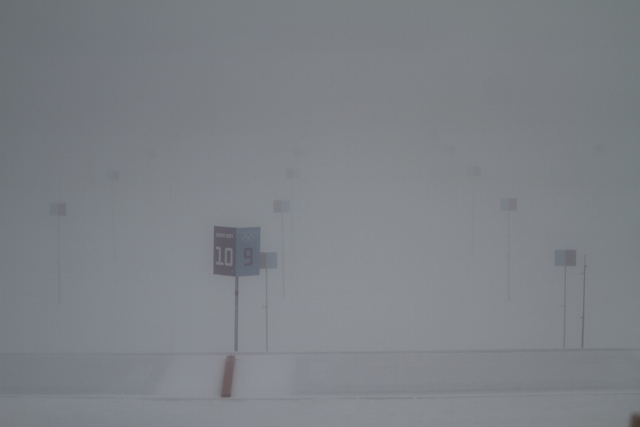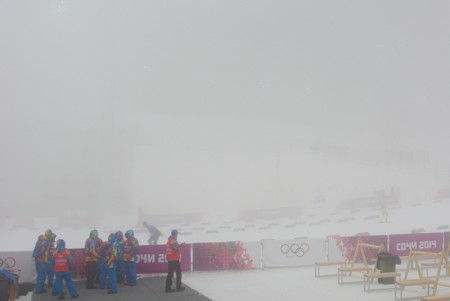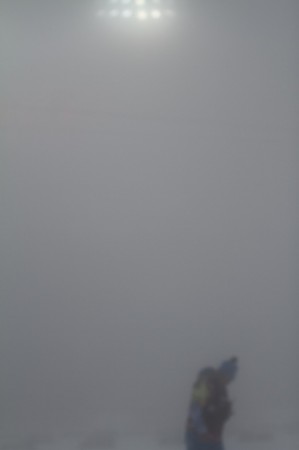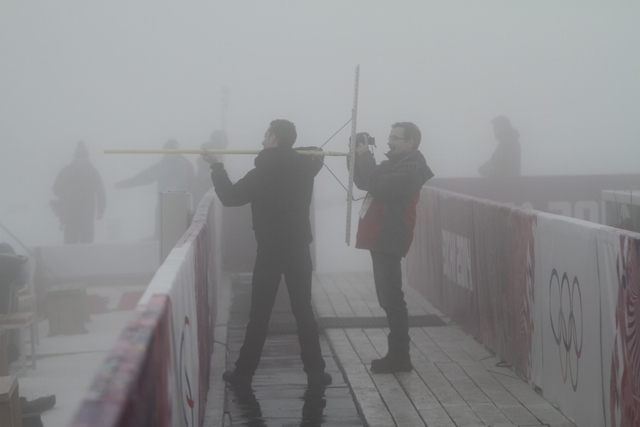
FasterSkier’s coverage is made possible through the generous support of Swix.
SOCHI, Russia – About an hour before Sunday’s men’s biathlon mass start competition was supposed to start, it was obvious that there was a problem.
That issue was a meteorological one with no immediate solution. A heavy fog rolled in over the mountains and completely obscured the stadium and trails. And it didn’t seem to have interest in leaving any time soon.
“The ski testing was all complete for both Tim [Burke] and Lowell [Bailey], and they had come to the zeroing but hadn’t started to shoot because there wasn’t much you could do,” U.S. High Performance Director Bernd Eisenbichler told FasterSkier.
There was no point in even looking down the range – it wasn’t even possible to see the back of the boards, much less to distinguish the black circular targets from their white backgrounds.
Chaos ensued as race organizers had to first delay the mass start for an hour, and then finally postpone it to the next day. Rumors of different start times were flying until an official announcement, just before the revised 8 p.m. start, concluded that 10 a.m. Monday would be the next plan.

That caused even more chaos among biathlon teams. All of the competitions so far have been between 6 and 7 p.m., and to adjust to the strange schedule many athletes have been staying up late and sleeping in very late as well – staying on central European time so that their bodies don’t recognize that they’re actually giving a hard effort when they should be eating dinner.
A 10 a.m. start was highly problematic given that strategy. Athletes would have to be on the range to begin zeroing their rifles at 9 a.m., a time when they had still been sleeping on some of the previous days.
“For sure, there was a lot of laughing in the dining hall that night by all the nations,” Eisenbichler said. “I think every team had tried to stay on European time. They were laughing about how early they would have to get up in the morning.”
Come Monday morning, however, the fog was still sitting tight. It was clear that a competition could not be held, but athletes, coaches, media, and spectators all waited for an official re-scheduling until long after the race was supposed to have gone off.
“Don’t thank me for having to get up at 7 a.m. for nothing!” French star Martin Fourcade, who has already won two gold medals at the Games, tweeted (in French).
Eisenbichler said that his two athletes, Burke and Bailey, had woken up, eaten breakfast, and prepared for the race. They were on the way to the venue when the team got word that the race would not happen at 10, even if the eventual start time was still unclear, so the guys turned around and went home.
“They were in a good mood and not too stressed,” Eisenbichler said.
Burke was joking about the change in schedule.
“Hurry up and wait. The race is again delayed because of fog. Back to bed for me!” he tweeted.

That is in sharp contrast to the race officials themselves. The problem? Delaying an Olympic event is not an easy feat, especially when it comes to the men’s mass start, a prestigious and exciting competition which draws huge ratings here in Russia as well as on television in Europe.
First, organizers have to contend with not only conditions on the range and the 7 p.m. start of the women’s mass start the same night. Thousands of fans have tickets for the race – many had showed up on Monday morning despite the weather – but even if athletes could see the range, spectators would be out of luck. With fog this thick, the shooting range is not visible from the stands. Spectators wouldn’t even be able to discern the giant video screens which broadcast both shooting and what is happening out on course.
Officials also must work around the schedules of rights-holding broadcasters and the Olympic Broadcast Service itself, which has to somehow slot the race in among its previously scheduled coverage. The jury meeting began around 8:30 a.m. this morning but the announcement was not made until 11 a.m., highlighting how compex the decision-making process has become.
It’s not the first time that biathlon has faced weather problems at the Olympics. In Vancouver, a snowstorm rolled in partway through the men’s sprint, making conditions highly variable between early and late starters. Four years later in hindsight, the consensus is that the race probably should have been called off.
And there would have been a precedent. In Nagano in 1998, the men’s sprint was canceled partway through, when Ole Einar Bjørndalen of Norway – then just 24 years old! – had finished and was in the lead. The race was rescheduled for the next day and Bjørndalen won again. It was the first gold of his career; in the sprint here in Sochi, he won his seventh.
At 11 a.m. local time – an hour after the race should have started – it was announced that 3:30 p.m. would be go time, although fog still cloaked the stadium. A French coach said that he doubted the race would happen at all today.
(UPDATE: at 2:15 p.m. local time, the 3:30 race was called off and postponed until Tuesday. A decision will be made at 4 p.m. regarding the women’s mass start, originally scheduled for 7 p.m. tonight.)
The Americans, however, remain unconcerned. Eisenbichler said that he believes his team is well-prepared for the uncertainty, as they are used to dealing with jetlag, lots of travel, and all of the ensuing scheduling snafus that issue from being based in North America and never racing at home. They are used to being ready for anything, which Eisenbichler believes is in contrast to the European teams who have more of a base during the World Cup season.
“It’s all about attitude and approach,” Eisenbichler said. “They were totally positive about it.”

Chelsea Little
Chelsea Little is FasterSkier's Editor-At-Large. A former racer at Ford Sayre, Dartmouth College and the Craftsbury Green Racing Project, she is a PhD candidate in aquatic ecology in the @Altermatt_lab at Eawag, the Swiss Federal Institute of Aquatic Science and Technology in Zurich, Switzerland. You can follow her on twitter @ChelskiLittle.



